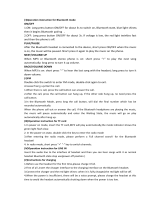
20 Chapter 3 : Email and other messages
Email
Set up email
BEFORE YOU BEGIN
• Before you use your phone to send or receive messages, check with your
wireless carrier for pricing and availability of email services and data rate
plans.
• Make sure your phone is on and you’re inside a coverage area before you
send or receive messages. If you want delivery of Microsoft Office
Outlook
®
email using Microsoft Direct Push, make sure that your IT
organization uses Exchange Server 2007, or Exchange Server 2003 with
Service Pack 2.
Follow this procedure if you have a common email provider, for example,
AOL, EarthLink, or Yahoo!
1 Open Email .
2 The first time you open Email, do one of the following:
• If this is the first email account you are setting up: The email address
you used for your Palm profile is entered by default. Use that
address, or enter an address for one of your other email accounts.
Enter your password for the account and tap Sign In.
• If you have already set up an account that takes advantage of the
Synergy feature and want to set up another one: Tap Add An
Account and enter the email address and password. Tap Sign In.
3 Any other time you open Email, open the application menu, tap
Preferences & Accounts, and tap Add An Account. Enter the email
address and password and tap Sign In.
4 Ta p Add An Account to add another account.
Create and send an email message
1 Open Email .
2 If this is the first time you have opened the Email application, and you
have set up at least one email account, tap Done. If you have not set
up an email account, see Set up email.
3 Ta p .
4 (Optional) Tap From to change the email account you are using to
send the message. This option appears only if you have more than one
email account set up on your phone.
5 In the To field, do one of the following to address the message:
• Enter a contact name, initials, or email address. Tap the email
address when it appears.
• Tap to open the full contact list. Tap the contact you want, or
enter a name or address to narrow the list.
• Enter the full email address for a recipient who is not a contact.
6 (Optional) Tap To to open the Cc and Bcc fields, and enter an address.
7 (Optional) Repeat steps 5 and 6 to enter additional addresses.
8 Enter the subject, press Enter , and enter the body text.
9 (Optional) To format body text, do one of the following:
• To enter bold, italic, or underlined text, open the application menu
and tap Edit > [the option you want]. Enter the text. To turn off the
formatting, open the application menu and tap Edit > [the option
you want to turn off].
• To enter colored text, open the application menu and tap Edit >
scroll down > Te x t Col o r . Tap the color and enter the text.
10 (Optional) To set the priority for the message, open the application
menu and tap Set As Normal Priority or Set As High Priority.
11 Tap .




















